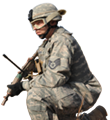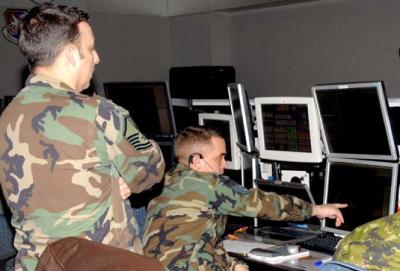NEADS Keeps an Eye on the Sky
| DMNA Home page | More News Stories |
NEADS controllers assist in fighter response to air space violation
Story by: Brooke Davis - Northeast Air Defense Sector
Dated: Sun, Aug 12, 2007
ROME, N.Y. - When a small aircraft strayed into the restricted airspace over Washington on Aug. 1, the citizen-Airmen of the Northeast Air Defense Sector (NEADS) played a role in intercepting the aircraft and escorting it our of the region.
The members of NEADS assisted in controlling two F-16 fighters, under the direction of North American Aerospace Defense Command, on a mission to intercept a small Cessna aircraft in the National Capital Region Air Defense Identification Zone, or ADIZ, at approximately 12:30 p.m. EST that day.
The civilian aircraft entered the ADIZ from the north and was headed south. After the intercept, the pilot re-established communications with local Federal Aviation Administration air traffic controllers and vacated the ADIZ heading west. As instructed by the air traffic controllers, the pilot then landed at Frederick Municipal Airport in Frederick, Md.
The fighters did not expend any flares--which they carry to attract an aircraft pilots attention-- during the intercept and returned to base after the civilian aircraft landed.
The Northeast Air Defense Sector, a New York Air National Guard unit that includes both Active Duty Air Force and Canadian personnel, plays an important role in performing NORAD’s mission. NEADS, in close collaboration with the Continental U.S. NORAD Region and law enforcement partners, prevents air attacks against the United States by responding to unknown, unwanted and unauthorized air activity approaching and operating within U.S. sovereign airspace.
The unit provides aerospace and maritime warning for North America and may be required to monitor, shadow, divert from flight path, direct to land and/or destroy platforms deemed a potential threat to North America.
Supporting the Continental U.S. NORAD Region’s homeland defense mission, NEADS assists in providing air sovereignty by executing counter-air operations over the entire eastern U.S., directing the employment of 94 sensors, eight fighter alert locations, Airborne Warning and Control System aircraft, a Battle Control Center (BCC) and joint air defense artillery assets to defend 1 million square miles, 16 major cities and adjacent seas.
URL: https://dmna.ny.gov/news/?id=1207946212
216.73.216.182
Page Last Modified: Fri, Jan 16, 2009




